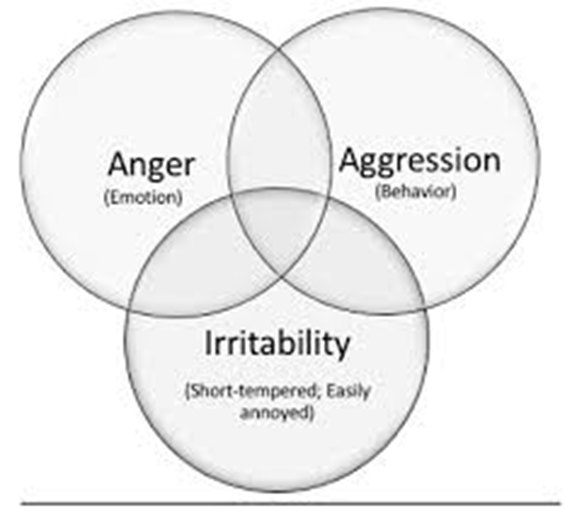An inpatient client who has a known history of violence suddenly begins to pace. Which additional client behavior should alert the nurse to escalating anger and aggression? The client:
Sits in group with back to peers.
Has a tense facial expression and body language.
Requests PRN medications.
Does not want to eat lunch.
The Correct Answer is B
Choice A: Sits in group with back to peers
Sitting with one’s back to peers can indicate a desire for isolation or a lack of trust, but it is not a definitive sign of escalating anger or aggression. This behavior might be more indicative of withdrawal or discomfort in social settings rather than an immediate precursor to violence.
Choice B: Has a tense facial expression and body language
This is the correct answer. Tense facial expressions and body language are clear indicators of escalating anger and aggression. Signs such as clenched fists, a rigid posture, and a furrowed brow are physical manifestations of internal tension and can precede aggressive outbursts. Recognizing these non-verbal cues is crucial for early intervention and de-escalation.

Choice C: Requests PRN medications
Requesting PRN (as needed) medications can be a sign that the client is experiencing increased anxiety or distress. However, this behavior alone does not necessarily indicate escalating aggression. It may actually be a positive sign that the client is seeking help to manage their symptoms before they escalate.
Choice D: Does not want to eat lunch
A lack of appetite or refusal to eat can be associated with various conditions, including depression, anxiety, or physical illness. While it may indicate that the client is not feeling well, it is not a specific indicator of escalating anger or aggression.
Nursing Test Bank
Naxlex Comprehensive Predictor Exams
Related Questions
Correct Answer is C
Explanation
Choice A Reason:
Obtunded describes a state where the patient has a decreased level of consciousness and is difficult to arouse. They may respond slowly and be somewhat confused. This level of consciousness is more severe than lethargy and typically requires more vigorous stimulation to elicit a response. The client’s ability to answer questions appropriately before falling back to sleep suggests a less severe impairment than obtundation.
Choice B Reason:
Stuporous refers to a condition where the patient is almost entirely unresponsive and can only be aroused by vigorous and repeated stimuli. This state is more severe than lethargy and obtundation. The client’s ability to respond appropriately to questions indicates a higher level of consciousness than stupor. Therefore, stuporous is not the correct description of the client’s condition.
Choice C Reason:
Lethargic describes a state where the patient is very drowsy but can be aroused to respond to questions and then falls back to sleep. This matches the client’s presentation as they are able to answer questions appropriately but fall asleep immediately afterward. Lethargy is a common level of altered consciousness in various medical conditions and is less severe than obtundation or stupor.
Choice D Reason:
Alert describes a state where the patient is fully awake, aware, and responsive to stimuli. The client’s tendency to fall back to sleep immediately after responding to questions indicates that they are not fully alert. Therefore, this term does not accurately describe the client’s level of consciousness.
Correct Answer is ["A","B","D"]
Explanation
Choice A Reason:
Slowed psychomotor activity.
Slowed psychomotor activity is a hallmark of hypoactive delirium. Patients with this type of delirium often exhibit reduced physical movement and slower reaction times. This symptom can make hypoactive delirium more challenging to recognize compared to the more obvious agitation seen in hyperactive delirium.
Choice B Reason:
Impaired attention and concentration.
Impaired attention and concentration are common in all forms of delirium, including hypoactive delirium. Patients may have difficulty focusing, sustaining, or shifting attention, which can significantly impact their ability to engage in daily activities or follow conversations.
Choice C Reason:
Hallucinations and delusions.
While hallucinations and delusions can occur in delirium, they are more commonly associated with hyperactive delirium. Hypoactive delirium is characterized more by withdrawal and decreased responsiveness rather than the presence of hallucinations or delusions.
Choice D Reason:
Decreased alertness or responsiveness.
Decreased alertness or responsiveness is a key feature of hypoactive delirium. Patients may appear drowsy, lethargic, or less responsive to their environment. This can sometimes be mistaken for depression or fatigue, making it crucial to differentiate hypoactive delirium from other conditions.
Choice E Reason:
Agitation and restlessness.
Agitation and restlessness are characteristic of hyperactive delirium, not hypoactive delirium5. In hypoactive delirium, patients are more likely to be withdrawn and less responsive rather than agitated or restless.
Whether you are a student looking to ace your exams or a practicing nurse seeking to enhance your expertise , our nursing education contents will empower you with the confidence and competence to make a difference in the lives of patients and become a respected leader in the healthcare field.
Visit Naxlex, invest in your future and unlock endless possibilities with our unparalleled nursing education contents today
Report Wrong Answer on the Current Question
Do you disagree with the answer? If yes, what is your expected answer? Explain.
Kindly be descriptive with the issue you are facing.
